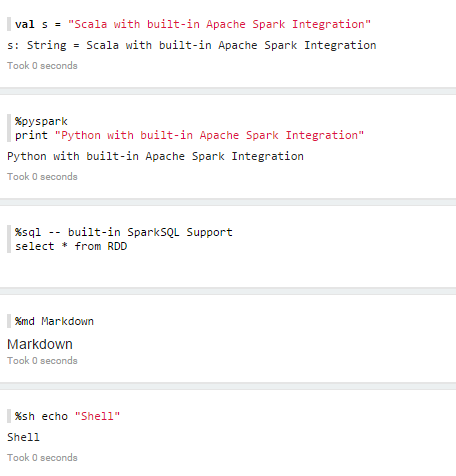Spark-zeppelin-大数据可视化分析
官网介绍
Multi-purpose Notebook
The Notebook is the place for all your needs
- Data Ingestion
- Data Discovery
- Data Analytics
- Data Visualization & Collaboration
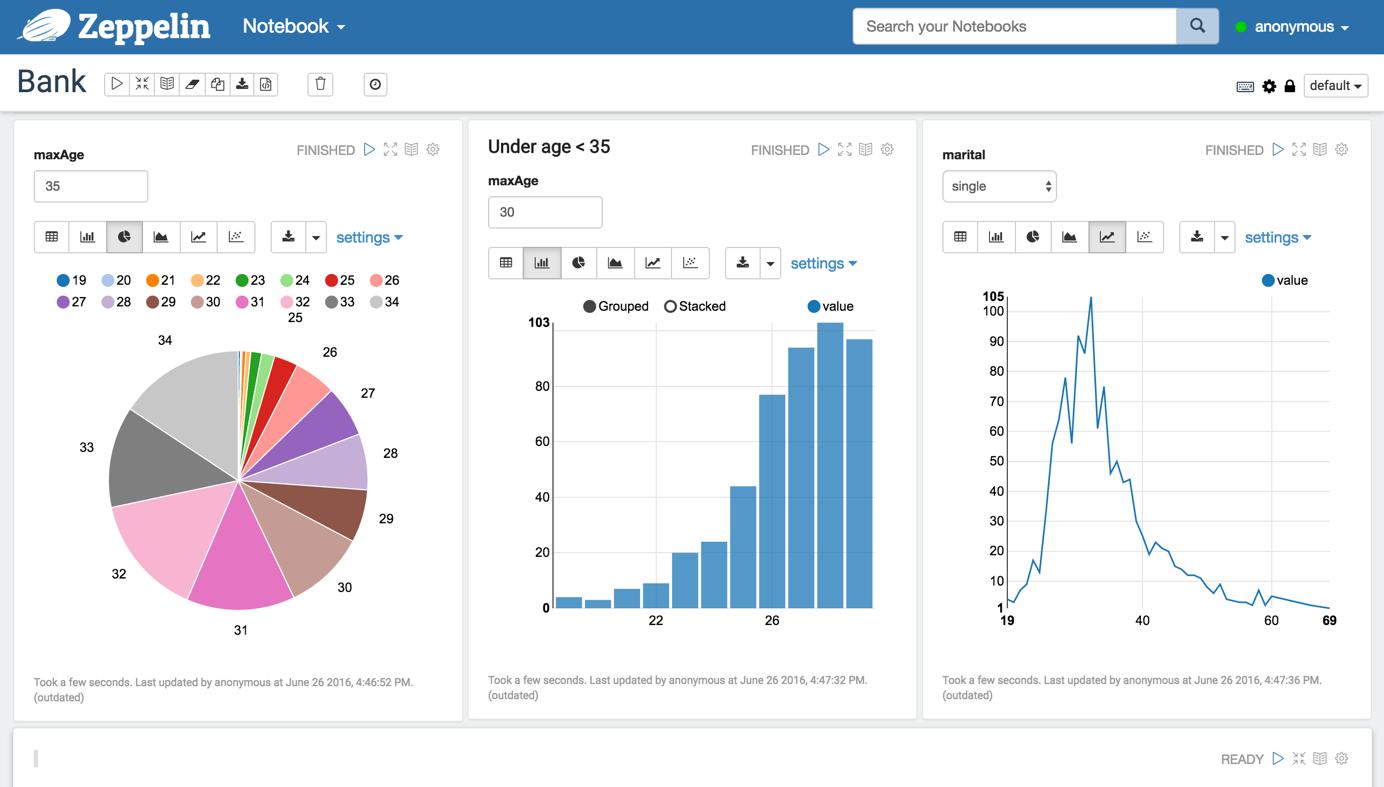
Multiple language backend
Zeppelin interpreter concept allows any language/data-processing-backend to be plugged into Zeppelin.Currently Zeppelin supports many interpreters such as Scala(with Apache Spark), Python(with Apache Spark), SparkSQL, Hive, Markdown and Shell.
Adding new language-backend is really simple. Learn how to write a zeppelin interpreter.
Apache Spark integration
Zeppelin provides built-in Apache Spark integration. You don't need to build a separate module, plugin or library for it.
Zeppelin's Spark integration provides
- Automatic SparkContext and SQLContext injection
- Runtime jar dependency loading from local filesystem or maven repository. Learn more aboutdependency loader.
- Canceling job and displaying its progress
Data visualization
Some basic charts are already included in Zeppelin. Visualizations are not limited to SparkSQL's query, any output from any language backend can be recognized and visualized.

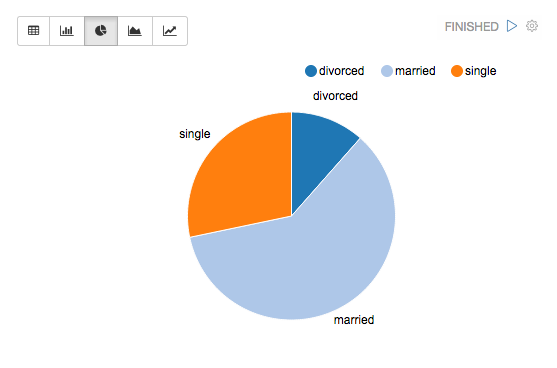
Pivot chart
With simple drag and drop Zeppelin aggeregates the values and display them in pivot chart. You can easily create chart with multiple aggregated values including sum, count, average, min, max.
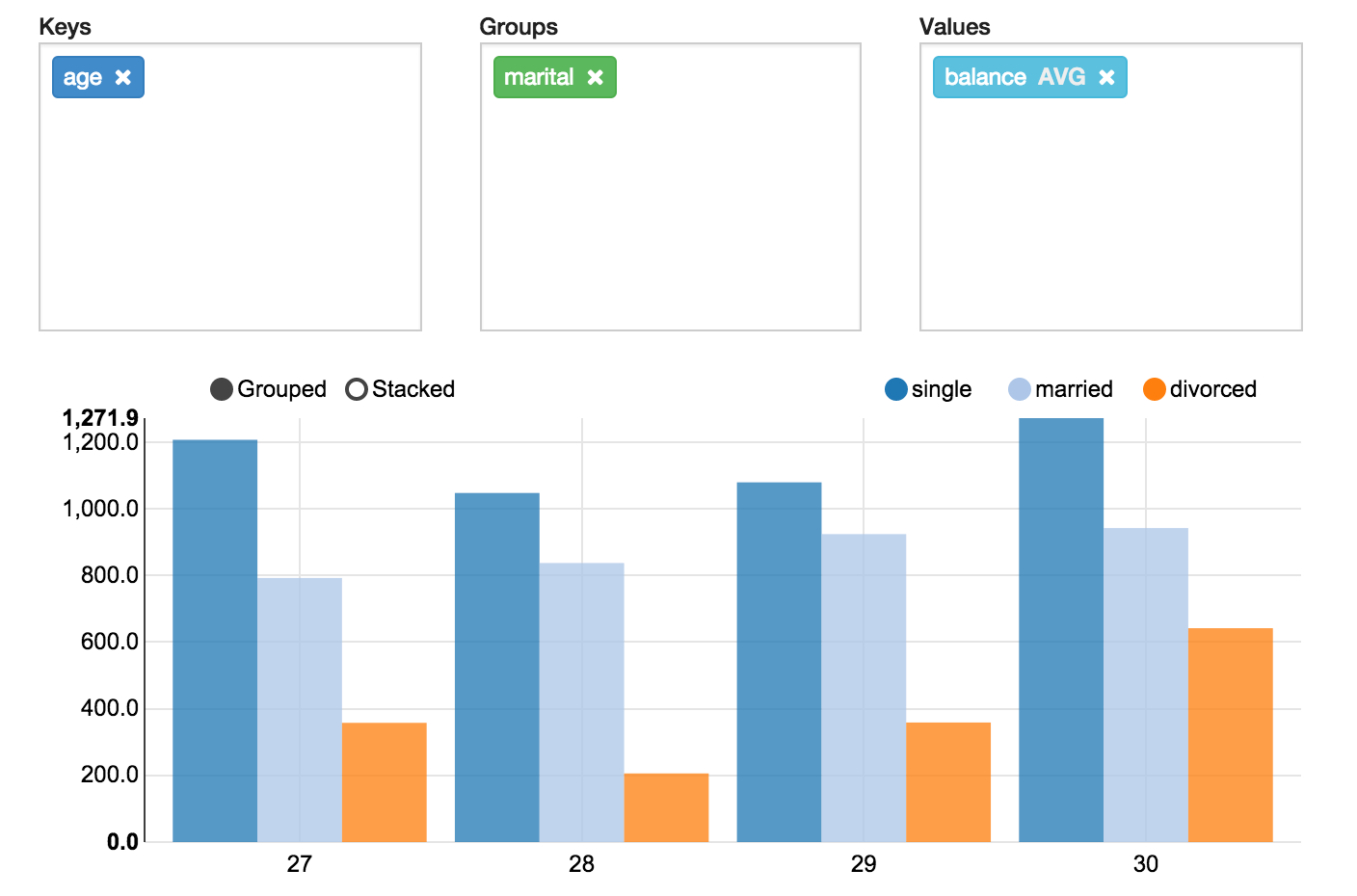
Learn more about Zeppelin's Display system. ( text, html, table, angular )
Dynamic forms
Zeppelin can dynamically create some input forms into your notebook.
Learn more about Dynamic Forms.
Collaboration
Notebook URL can be shared among collaborators. Zeppelin can then broadcast any changes in realtime, just like the collaboration in Google docs.
Publish
Zeppelin provides an URL to display the result only, that page does not include Zeppelin's menu and buttons.This way, you can easily embed it as an iframe inside of your website.
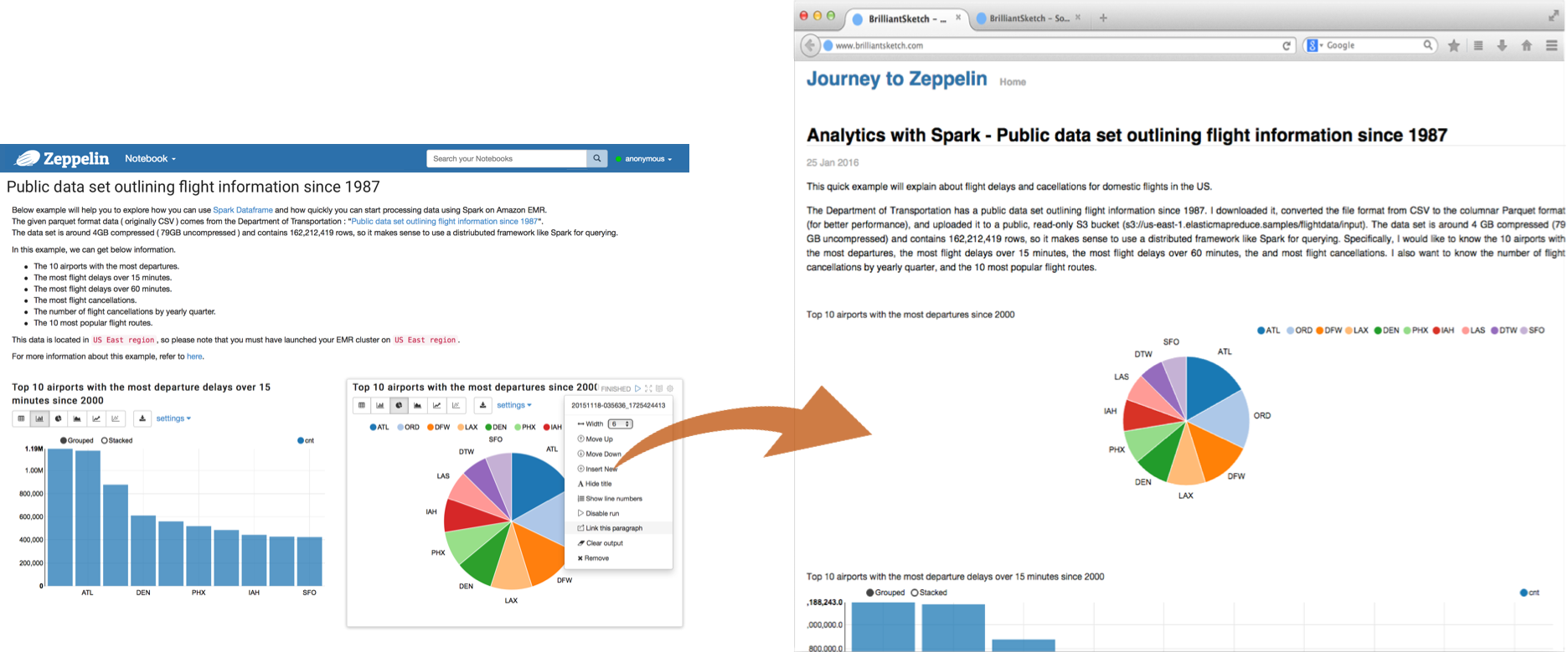
100% Opensource
Apache Zeppelin (incubating) is Apache2 Licensed software. Please check out thesource repository andHow to contribute
Zeppelin has a very active development community.Join the Mailing list and report issues on our Issue tracker.
Undergoing Incubation
Apache Zeppelin is an effort undergoing incubation at The Apache Software Foundation (ASF), sponsored by the Incubator. Incubation is required of all newly accepted projects until a further review indicates that the infrastructure, communications, and decision making process have stabilized in a manner consistent with other successful ASF projects. While incubation status is not necessarily a reflection of the completeness or stability of the code, it does indicate that the project has yet to be fully endorsed by the ASF.
安装From binary package
Download latest binary package from Download.
Build from source
Check instructions in README to build from source.
Configure
Configuration can be done by both environment variable(conf/zeppelin-env.sh) and java properties(conf/zeppelin-site.xml). If both defined, environment vaiable is used.
| zepplin-env.sh | zepplin-site.xml | Default value | Description |
|---|---|---|---|
| ZEPPELIN_PORT | zeppelin.server.port | 8080 | Zeppelin server port. |
| ZEPPELIN_MEM | N/A | -Xmx1024m -XX:MaxPermSize=512m | JVM mem options |
| ZEPPELIN_INTP_MEM | N/A | ZEPPELIN_MEM | JVM mem options for interpreter process |
| ZEPPELIN_JAVA_OPTS | N/A | JVM Options | |
| ZEPPELIN_ALLOWED_ORIGINS | zeppelin.server.allowed.origins | * | Allows a way to specify a ',' separated list of allowed origins for rest and websockets. i.e. http://localhost:8080 |
| ZEPPELIN_SERVER_CONTEXT_PATH | zeppelin.server.context.path | / | Context Path of the Web Application |
| ZEPPELIN_SSL | zeppelin.ssl | false | |
| ZEPPELIN_SSL_CLIENT_AUTH | zeppelin.ssl.client.auth | false | |
| ZEPPELIN_SSL_KEYSTORE_PATH | zeppelin.ssl.keystore.path | keystore | |
| ZEPPELIN_SSL_KEYSTORE_TYPE | zeppelin.ssl.keystore.type | JKS | |
| ZEPPELIN_SSL_KEYSTORE_PASSWORD | zeppelin.ssl.keystore.password | ||
| ZEPPELIN_SSL_KEY_MANAGER_PASSWORD | zeppelin.ssl.key.manager.password | ||
| ZEPPELIN_SSL_TRUSTSTORE_PATH | zeppelin.ssl.truststore.path | ||
| ZEPPELIN_SSL_TRUSTSTORE_TYPE | zeppelin.ssl.truststore.type | ||
| ZEPPELIN_SSL_TRUSTSTORE_PASSWORD | zeppelin.ssl.truststore.password | ||
| ZEPPELIN_NOTEBOOK_HOMESCREEN | zeppelin.notebook.homescreen | Id of notebook to be displayed in homescreen ex) 2A94M5J1Z | |
| ZEPPELIN_NOTEBOOK_HOMESCREEN_HIDE | zeppelin.notebook.homescreen.hide | false | hide homescreen notebook from list when this value set to "true" |
| ZEPPELIN_WAR_TEMPDIR | zeppelin.war.tempdir | webapps | The location of jetty temporary directory. |
| ZEPPELIN_NOTEBOOK_DIR | zeppelin.notebook.dir | notebook | Where notebook file is saved |
| ZEPPELIN_NOTEBOOK_S3_BUCKET | zeppelin.notebook.s3.bucket | zeppelin | Bucket where notebook saved |
| ZEPPELIN_NOTEBOOK_S3_USER | zeppelin.notebook.s3.user | user | User in bucket where notebook saved. For example bucket/user/notebook/2A94M5J1Z/note.json |
| ZEPPELIN_NOTEBOOK_STORAGE | zeppelin.notebook.storage | org.apache.zeppelin.notebook.repo.VFSNotebookRepo | Comma separated list of notebook storage |
| ZEPPELIN_INTERPRETERS | zeppelin.interpreters | org.apache.zeppelin.spark.SparkInterpreter, org.apache.zeppelin.spark.PySparkInterpreter, org.apache.zeppelin.spark.SparkSqlInterpreter, org.apache.zeppelin.spark.DepInterpreter, org.apache.zeppelin.markdown.Markdown, org.apache.zeppelin.shell.ShellInterpreter, org.apache.zeppelin.hive.HiveInterpreter ... |
Comma separated interpreter configurations [Class]. First interpreter become a default |
| ZEPPELIN_INTERPRETER_DIR | zeppelin.interpreter.dir | interpreter | Zeppelin interpreter directory |
You'll also need to configure individual interpreter. Information can be found in 'Interpreter' section in this documentation.
For example Spark.
Start/Stop
Start Zeppelin
bin/zeppelin-daemon.sh start
After successful start, visit http://localhost:8080 with your web browser.
Stop Zeppelin
bin/zeppelin-daemon.sh stop
Zeppelin Tutorial
We will assume you have Zeppelin installed already. If that's not the case, seeInstall.
Zeppelin's current main backend processing engine is Apache Spark. If you're new to the system, you might want to start by getting an idea of how it processes data to get the most out of Zeppelin.
Tutorial with Local File
Data Refine
Before you start Zeppelin tutorial, you will need to download bank.zip.
First, to transform data from csv format into RDD of Bank objects, run following script. This will also remove header usingfilter function.
val bankText = sc.textFile("yourPath/bank/bank-full.csv")
case class Bank(age:Integer, job:String, marital : String, education : String, balance : Integer)
// split each line, filter out header (starts with "age"), and map it into Bank case class
val bank = bankText.map(s=>s.split(";")).filter(s=>s(0)!="\"age\"").map(
s=>Bank(s(0).toInt,
s(1).replaceAll("\"", ""),
s(2).replaceAll("\"", ""),
s(3).replaceAll("\"", ""),
s(5).replaceAll("\"", "").toInt
)
)
// convert to DataFrame and create temporal table
bank.toDF().registerTempTable("bank")
Data Retrieval
Suppose we want to see age distribution from bank. To do this, run:
%sql select age, count(1) from bank where age < 30 group by age order by age
You can make input box for setting age condition by replacing 30 with${maxAge=30}.
%sql select age, count(1) from bank where age < ${maxAge=30} group by age order by age
Now we want to see age distribution with certain marital status and add combo box to select marital status. Run:
%sql select age, count(1) from bank where marital="${marital=single,single|divorced|married}" group by age order by age
Tutorial with Streaming Data
Data Refine
Since this tutorial is based on Twitter's sample tweet stream, you must configure authentication with a Twitter account. To do this, take a look atTwitter Credential Setup. After you get API keys, you should fill out credential related values(apiKey,apiSecret, accessToken, accessTokenSecret) with your API keys on following script.
This will create a RDD of Tweet objects and register these stream data as a table:
import org.apache.spark.streaming._
import org.apache.spark.streaming.twitter._
import org.apache.spark.storage.StorageLevel
import scala.io.Source
import scala.collection.mutable.HashMap
import java.io.File
import org.apache.log4j.Logger
import org.apache.log4j.Level
import sys.process.stringSeqToProcess
/** Configures the Oauth Credentials for accessing Twitter */
def configureTwitterCredentials(apiKey: String, apiSecret: String, accessToken: String, accessTokenSecret: String) {
val configs = new HashMap[String, String] ++= Seq(
"apiKey" -> apiKey, "apiSecret" -> apiSecret, "accessToken" -> accessToken, "accessTokenSecret" -> accessTokenSecret)
println("Configuring Twitter OAuth")
configs.foreach{ case(key, value) =>
if (value.trim.isEmpty) {
throw new Exception("Error setting authentication - value for " + key + " not set")
}
val fullKey = "twitter4j.oauth." + key.replace("api", "consumer")
System.setProperty(fullKey, value.trim)
println("\tProperty " + fullKey + " set as [" + value.trim + "]")
}
println()
}
// Configure Twitter credentials
val apiKey = "xxxxxxxxxxxxxxxxxxxxxxxxx"
val apiSecret = "xxxxxxxxxxxxxxxxxxxxxxxxxxxxxxxxxxxxxxxxxxxxxxxxxx"
val accessToken = "xxxxxxxxxxxxxxxxxxxxxxxxxxxxxxxxxxxxxxxxxxxxxxxxxx"
val accessTokenSecret = "xxxxxxxxxxxxxxxxxxxxxxxxxxxxxxxxxxxxxxxxxxxxx"
configureTwitterCredentials(apiKey, apiSecret, accessToken, accessTokenSecret)
import org.apache.spark.streaming.twitter._
val ssc = new StreamingContext(sc, Seconds(2))
val tweets = TwitterUtils.createStream(ssc, None)
val twt = tweets.window(Seconds(60))
case class Tweet(createdAt:Long, text:String)
twt.map(status=>
Tweet(status.getCreatedAt().getTime()/1000, status.getText())
).foreachRDD(rdd=>
// Below line works only in spark 1.3.0.
// For spark 1.1.x and spark 1.2.x,
// use rdd.registerTempTable("tweets") instead.
rdd.toDF().registerAsTable("tweets")
)
twt.print
ssc.start()
Data Retrieval
For each following script, every time you click run button you will see different result since it is based on real-time data.
Let's begin by extracting maximum 10 tweets which contain the word "girl".
%sql select * from tweets where text like '%girl%' limit 10
This time suppose we want to see how many tweets have been created per sec during last 60 sec. To do this, run:
%sql select createdAt, count(1) from tweets group by createdAt order by createdAt
You can make user-defined function and use it in Spark SQL. Let's try it by making function namedsentiment. This function will return one of the three attitudes(positive, negative, neutral) towards the parameter.
def sentiment(s:String) : String = {
val positive = Array("like", "love", "good", "great", "happy", "cool", "the", "one", "that")
val negative = Array("hate", "bad", "stupid", "is")
var st = 0;
val words = s.split(" ")
positive.foreach(p =>
words.foreach(w =>
if(p==w) st = st+1
)
)
negative.foreach(p=>
words.foreach(w=>
if(p==w) st = st-1
)
)
if(st>0)
"positivie"
else if(st<0)
"negative"
else
"neutral"
}
// Below line works only in spark 1.3.0.
// For spark 1.1.x and spark 1.2.x,
// use sqlc.registerFunction("sentiment", sentiment _) instead.
sqlc.udf.register("sentiment", sentiment _)
To check how people think about girls using sentiment function we've made above, run this:
%sql select sentiment(text), count(1) from tweets where text like '%girl%' group by sentiment(text)
